Assessing Quality and Safety in Australian Healthcare - NRS3806 Report
VerifiedAdded on 2022/09/11
|11
|3109
|16
Report
AI Summary
This report examines quality and safety within the Australian healthcare system, specifically focusing on the National Safety and Quality Health Service (NSQHS) Standard 3, which addresses preventing and controlling healthcare-associated infections (HAIs). The paper discusses the importance of quality and safety, and how healthcare organizations address these aspects. It critically analyzes the role of hand hygiene (HH) in improving safety and quality, emphasizing the WHO's five moments for HH. The report defines process and outcome data, providing examples and discussing data collection methods, and the use of feedback to improve healthcare quality and safety. The report references the Donabedian model and various studies to support its arguments, concluding that improving HH compliance and reducing HAIs are crucial for enhancing patient outcomes and overall healthcare quality. The student assignment is a report for the NRS3806 Professional Nursing Practice course at Griffith University.
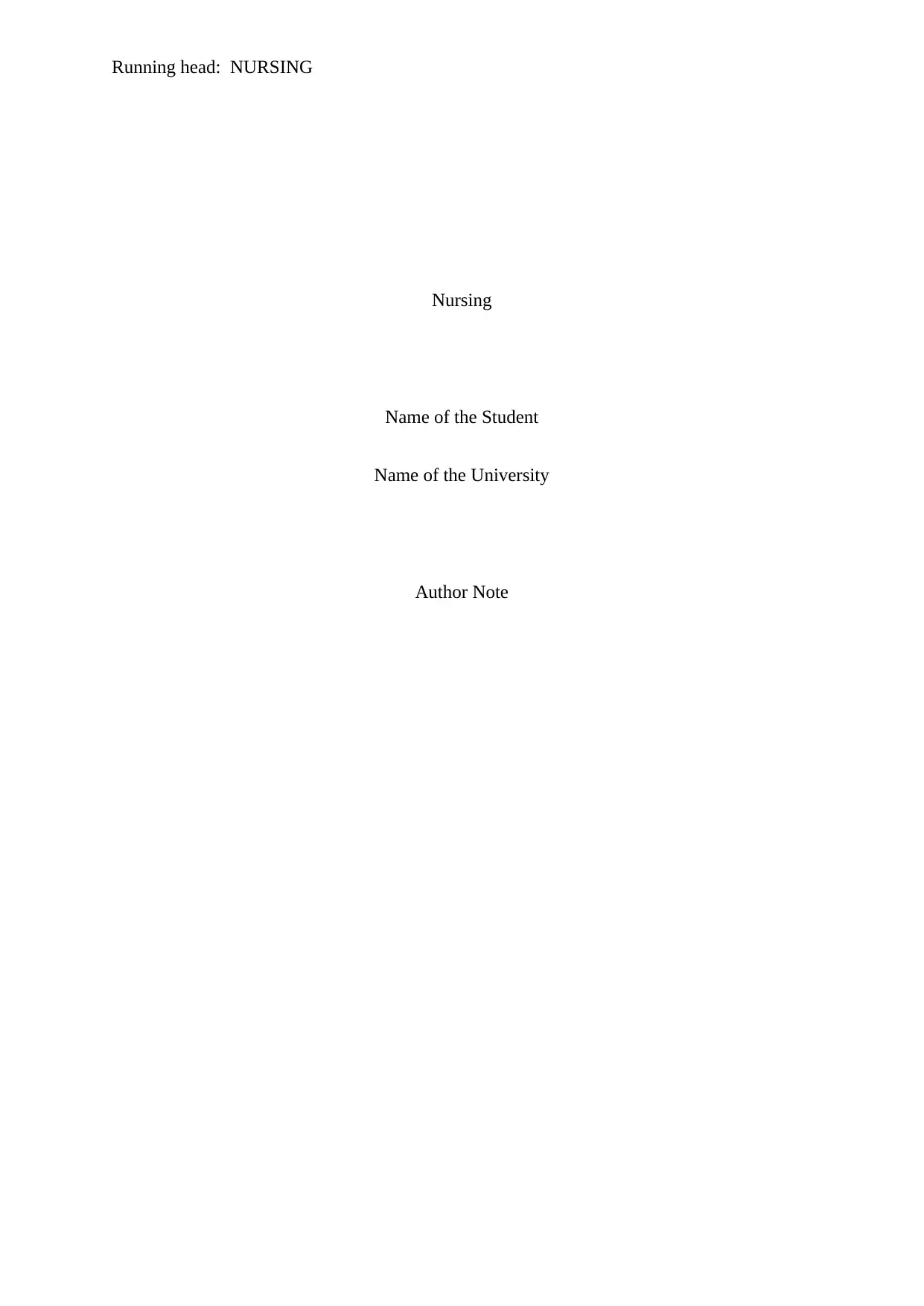
Running head: NURSING
Nursing
Name of the Student
Name of the University
Author Note
Nursing
Name of the Student
Name of the University
Author Note
Paraphrase This Document
Need a fresh take? Get an instant paraphrase of this document with our AI Paraphraser
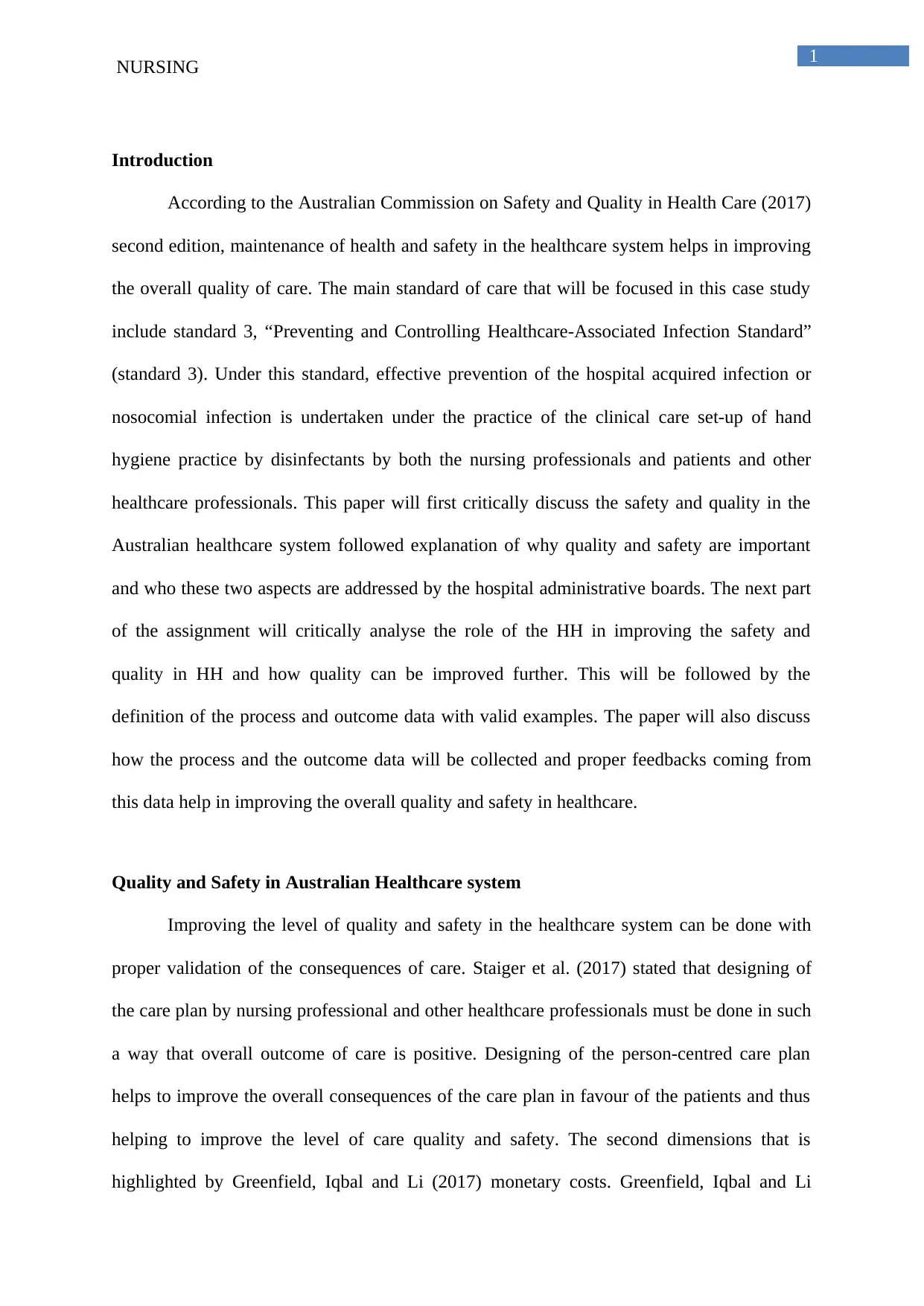
1
NURSING
Introduction
According to the Australian Commission on Safety and Quality in Health Care (2017)
second edition, maintenance of health and safety in the healthcare system helps in improving
the overall quality of care. The main standard of care that will be focused in this case study
include standard 3, “Preventing and Controlling Healthcare-Associated Infection Standard”
(standard 3). Under this standard, effective prevention of the hospital acquired infection or
nosocomial infection is undertaken under the practice of the clinical care set-up of hand
hygiene practice by disinfectants by both the nursing professionals and patients and other
healthcare professionals. This paper will first critically discuss the safety and quality in the
Australian healthcare system followed explanation of why quality and safety are important
and who these two aspects are addressed by the hospital administrative boards. The next part
of the assignment will critically analyse the role of the HH in improving the safety and
quality in HH and how quality can be improved further. This will be followed by the
definition of the process and outcome data with valid examples. The paper will also discuss
how the process and the outcome data will be collected and proper feedbacks coming from
this data help in improving the overall quality and safety in healthcare.
Quality and Safety in Australian Healthcare system
Improving the level of quality and safety in the healthcare system can be done with
proper validation of the consequences of care. Staiger et al. (2017) stated that designing of
the care plan by nursing professional and other healthcare professionals must be done in such
a way that overall outcome of care is positive. Designing of the person-centred care plan
helps to improve the overall consequences of the care plan in favour of the patients and thus
helping to improve the level of care quality and safety. The second dimensions that is
highlighted by Greenfield, Iqbal and Li (2017) monetary costs. Greenfield, Iqbal and Li
NURSING
Introduction
According to the Australian Commission on Safety and Quality in Health Care (2017)
second edition, maintenance of health and safety in the healthcare system helps in improving
the overall quality of care. The main standard of care that will be focused in this case study
include standard 3, “Preventing and Controlling Healthcare-Associated Infection Standard”
(standard 3). Under this standard, effective prevention of the hospital acquired infection or
nosocomial infection is undertaken under the practice of the clinical care set-up of hand
hygiene practice by disinfectants by both the nursing professionals and patients and other
healthcare professionals. This paper will first critically discuss the safety and quality in the
Australian healthcare system followed explanation of why quality and safety are important
and who these two aspects are addressed by the hospital administrative boards. The next part
of the assignment will critically analyse the role of the HH in improving the safety and
quality in HH and how quality can be improved further. This will be followed by the
definition of the process and outcome data with valid examples. The paper will also discuss
how the process and the outcome data will be collected and proper feedbacks coming from
this data help in improving the overall quality and safety in healthcare.
Quality and Safety in Australian Healthcare system
Improving the level of quality and safety in the healthcare system can be done with
proper validation of the consequences of care. Staiger et al. (2017) stated that designing of
the care plan by nursing professional and other healthcare professionals must be done in such
a way that overall outcome of care is positive. Designing of the person-centred care plan
helps to improve the overall consequences of the care plan in favour of the patients and thus
helping to improve the level of care quality and safety. The second dimensions that is
highlighted by Greenfield, Iqbal and Li (2017) monetary costs. Greenfield, Iqbal and Li
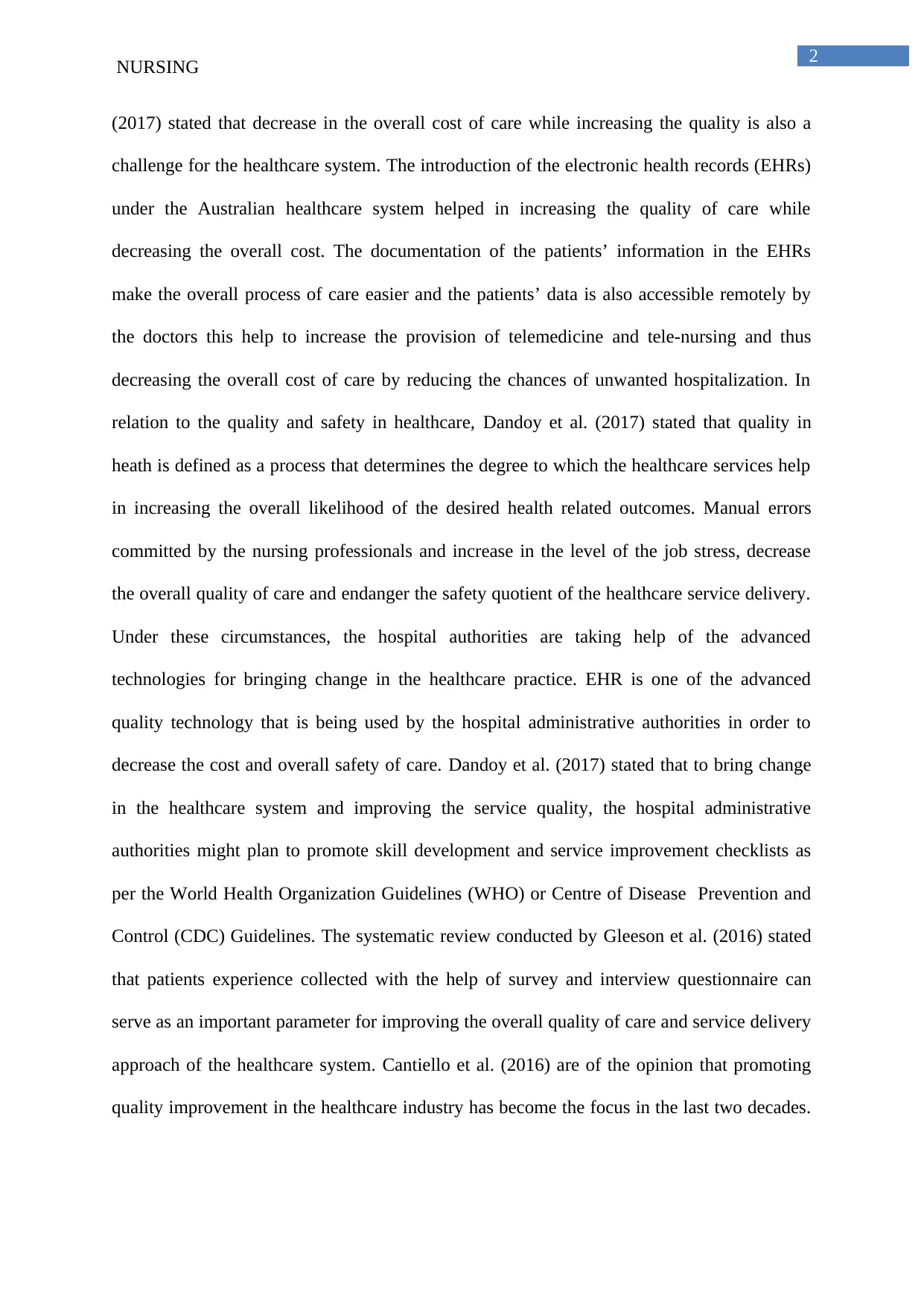
2
NURSING
(2017) stated that decrease in the overall cost of care while increasing the quality is also a
challenge for the healthcare system. The introduction of the electronic health records (EHRs)
under the Australian healthcare system helped in increasing the quality of care while
decreasing the overall cost. The documentation of the patients’ information in the EHRs
make the overall process of care easier and the patients’ data is also accessible remotely by
the doctors this help to increase the provision of telemedicine and tele-nursing and thus
decreasing the overall cost of care by reducing the chances of unwanted hospitalization. In
relation to the quality and safety in healthcare, Dandoy et al. (2017) stated that quality in
heath is defined as a process that determines the degree to which the healthcare services help
in increasing the overall likelihood of the desired health related outcomes. Manual errors
committed by the nursing professionals and increase in the level of the job stress, decrease
the overall quality of care and endanger the safety quotient of the healthcare service delivery.
Under these circumstances, the hospital authorities are taking help of the advanced
technologies for bringing change in the healthcare practice. EHR is one of the advanced
quality technology that is being used by the hospital administrative authorities in order to
decrease the cost and overall safety of care. Dandoy et al. (2017) stated that to bring change
in the healthcare system and improving the service quality, the hospital administrative
authorities might plan to promote skill development and service improvement checklists as
per the World Health Organization Guidelines (WHO) or Centre of Disease Prevention and
Control (CDC) Guidelines. The systematic review conducted by Gleeson et al. (2016) stated
that patients experience collected with the help of survey and interview questionnaire can
serve as an important parameter for improving the overall quality of care and service delivery
approach of the healthcare system. Cantiello et al. (2016) are of the opinion that promoting
quality improvement in the healthcare industry has become the focus in the last two decades.
NURSING
(2017) stated that decrease in the overall cost of care while increasing the quality is also a
challenge for the healthcare system. The introduction of the electronic health records (EHRs)
under the Australian healthcare system helped in increasing the quality of care while
decreasing the overall cost. The documentation of the patients’ information in the EHRs
make the overall process of care easier and the patients’ data is also accessible remotely by
the doctors this help to increase the provision of telemedicine and tele-nursing and thus
decreasing the overall cost of care by reducing the chances of unwanted hospitalization. In
relation to the quality and safety in healthcare, Dandoy et al. (2017) stated that quality in
heath is defined as a process that determines the degree to which the healthcare services help
in increasing the overall likelihood of the desired health related outcomes. Manual errors
committed by the nursing professionals and increase in the level of the job stress, decrease
the overall quality of care and endanger the safety quotient of the healthcare service delivery.
Under these circumstances, the hospital authorities are taking help of the advanced
technologies for bringing change in the healthcare practice. EHR is one of the advanced
quality technology that is being used by the hospital administrative authorities in order to
decrease the cost and overall safety of care. Dandoy et al. (2017) stated that to bring change
in the healthcare system and improving the service quality, the hospital administrative
authorities might plan to promote skill development and service improvement checklists as
per the World Health Organization Guidelines (WHO) or Centre of Disease Prevention and
Control (CDC) Guidelines. The systematic review conducted by Gleeson et al. (2016) stated
that patients experience collected with the help of survey and interview questionnaire can
serve as an important parameter for improving the overall quality of care and service delivery
approach of the healthcare system. Cantiello et al. (2016) are of the opinion that promoting
quality improvement in the healthcare industry has become the focus in the last two decades.
⊘ This is a preview!⊘
Do you want full access?
Subscribe today to unlock all pages.

Trusted by 1+ million students worldwide
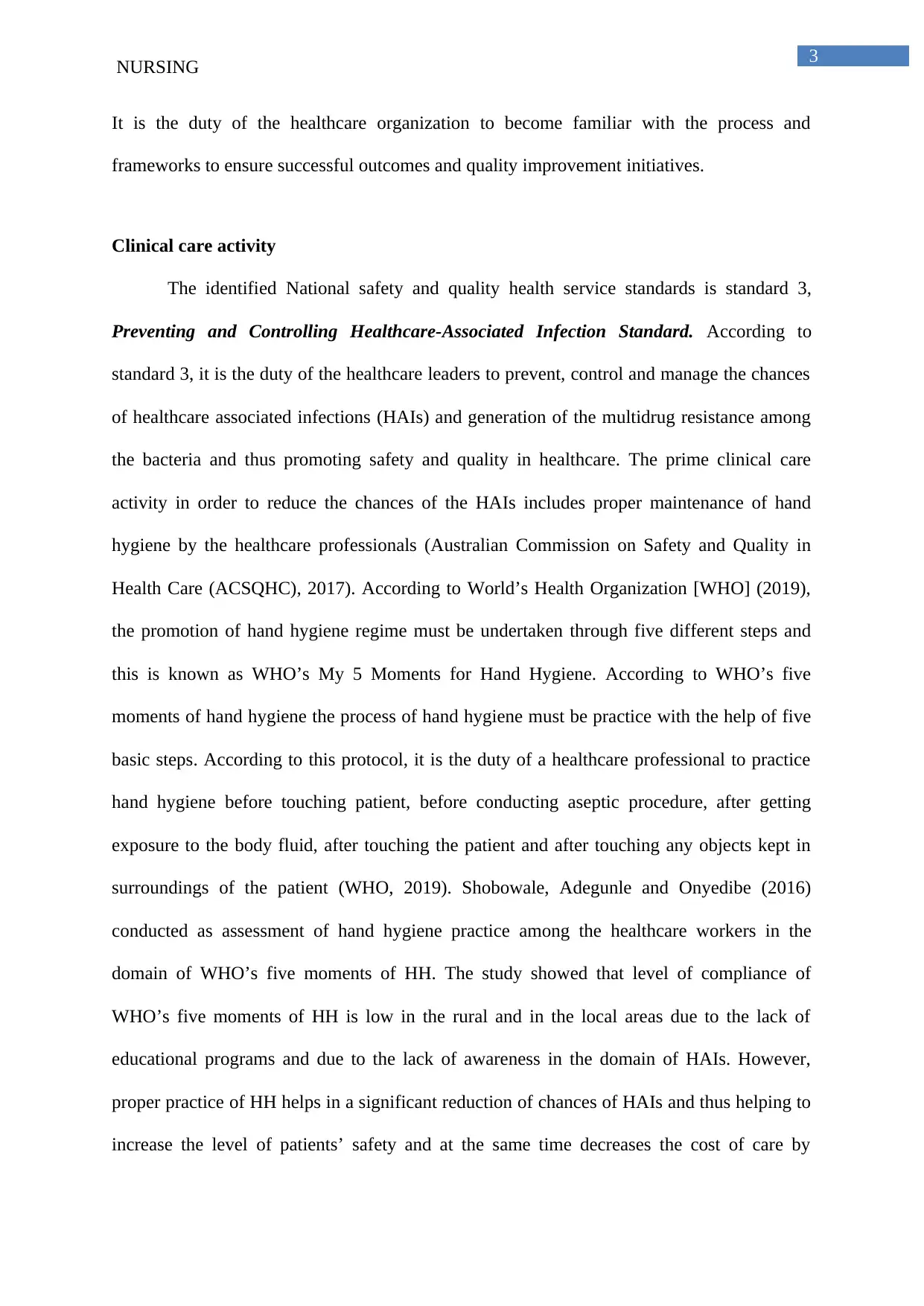
3
NURSING
It is the duty of the healthcare organization to become familiar with the process and
frameworks to ensure successful outcomes and quality improvement initiatives.
Clinical care activity
The identified National safety and quality health service standards is standard 3,
Preventing and Controlling Healthcare-Associated Infection Standard. According to
standard 3, it is the duty of the healthcare leaders to prevent, control and manage the chances
of healthcare associated infections (HAIs) and generation of the multidrug resistance among
the bacteria and thus promoting safety and quality in healthcare. The prime clinical care
activity in order to reduce the chances of the HAIs includes proper maintenance of hand
hygiene by the healthcare professionals (Australian Commission on Safety and Quality in
Health Care (ACSQHC), 2017). According to World’s Health Organization [WHO] (2019),
the promotion of hand hygiene regime must be undertaken through five different steps and
this is known as WHO’s My 5 Moments for Hand Hygiene. According to WHO’s five
moments of hand hygiene the process of hand hygiene must be practice with the help of five
basic steps. According to this protocol, it is the duty of a healthcare professional to practice
hand hygiene before touching patient, before conducting aseptic procedure, after getting
exposure to the body fluid, after touching the patient and after touching any objects kept in
surroundings of the patient (WHO, 2019). Shobowale, Adegunle and Onyedibe (2016)
conducted as assessment of hand hygiene practice among the healthcare workers in the
domain of WHO’s five moments of HH. The study showed that level of compliance of
WHO’s five moments of HH is low in the rural and in the local areas due to the lack of
educational programs and due to the lack of awareness in the domain of HAIs. However,
proper practice of HH helps in a significant reduction of chances of HAIs and thus helping to
increase the level of patients’ safety and at the same time decreases the cost of care by
NURSING
It is the duty of the healthcare organization to become familiar with the process and
frameworks to ensure successful outcomes and quality improvement initiatives.
Clinical care activity
The identified National safety and quality health service standards is standard 3,
Preventing and Controlling Healthcare-Associated Infection Standard. According to
standard 3, it is the duty of the healthcare leaders to prevent, control and manage the chances
of healthcare associated infections (HAIs) and generation of the multidrug resistance among
the bacteria and thus promoting safety and quality in healthcare. The prime clinical care
activity in order to reduce the chances of the HAIs includes proper maintenance of hand
hygiene by the healthcare professionals (Australian Commission on Safety and Quality in
Health Care (ACSQHC), 2017). According to World’s Health Organization [WHO] (2019),
the promotion of hand hygiene regime must be undertaken through five different steps and
this is known as WHO’s My 5 Moments for Hand Hygiene. According to WHO’s five
moments of hand hygiene the process of hand hygiene must be practice with the help of five
basic steps. According to this protocol, it is the duty of a healthcare professional to practice
hand hygiene before touching patient, before conducting aseptic procedure, after getting
exposure to the body fluid, after touching the patient and after touching any objects kept in
surroundings of the patient (WHO, 2019). Shobowale, Adegunle and Onyedibe (2016)
conducted as assessment of hand hygiene practice among the healthcare workers in the
domain of WHO’s five moments of HH. The study showed that level of compliance of
WHO’s five moments of HH is low in the rural and in the local areas due to the lack of
educational programs and due to the lack of awareness in the domain of HAIs. However,
proper practice of HH helps in a significant reduction of chances of HAIs and thus helping to
increase the level of patients’ safety and at the same time decreases the cost of care by
Paraphrase This Document
Need a fresh take? Get an instant paraphrase of this document with our AI Paraphraser
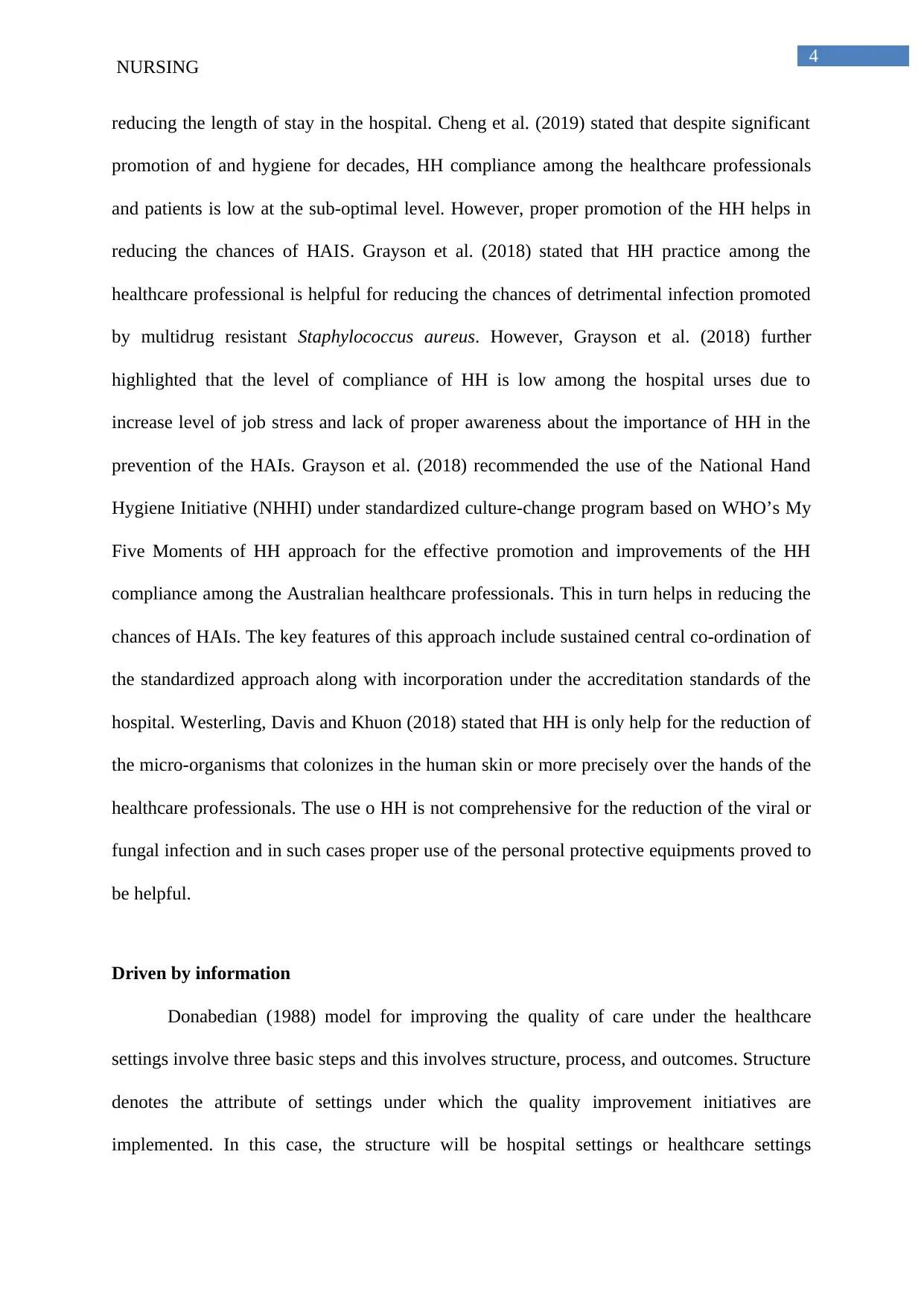
4
NURSING
reducing the length of stay in the hospital. Cheng et al. (2019) stated that despite significant
promotion of and hygiene for decades, HH compliance among the healthcare professionals
and patients is low at the sub-optimal level. However, proper promotion of the HH helps in
reducing the chances of HAIS. Grayson et al. (2018) stated that HH practice among the
healthcare professional is helpful for reducing the chances of detrimental infection promoted
by multidrug resistant Staphylococcus aureus. However, Grayson et al. (2018) further
highlighted that the level of compliance of HH is low among the hospital urses due to
increase level of job stress and lack of proper awareness about the importance of HH in the
prevention of the HAIs. Grayson et al. (2018) recommended the use of the National Hand
Hygiene Initiative (NHHI) under standardized culture-change program based on WHO’s My
Five Moments of HH approach for the effective promotion and improvements of the HH
compliance among the Australian healthcare professionals. This in turn helps in reducing the
chances of HAIs. The key features of this approach include sustained central co-ordination of
the standardized approach along with incorporation under the accreditation standards of the
hospital. Westerling, Davis and Khuon (2018) stated that HH is only help for the reduction of
the micro-organisms that colonizes in the human skin or more precisely over the hands of the
healthcare professionals. The use o HH is not comprehensive for the reduction of the viral or
fungal infection and in such cases proper use of the personal protective equipments proved to
be helpful.
Driven by information
Donabedian (1988) model for improving the quality of care under the healthcare
settings involve three basic steps and this involves structure, process, and outcomes. Structure
denotes the attribute of settings under which the quality improvement initiatives are
implemented. In this case, the structure will be hospital settings or healthcare settings
NURSING
reducing the length of stay in the hospital. Cheng et al. (2019) stated that despite significant
promotion of and hygiene for decades, HH compliance among the healthcare professionals
and patients is low at the sub-optimal level. However, proper promotion of the HH helps in
reducing the chances of HAIS. Grayson et al. (2018) stated that HH practice among the
healthcare professional is helpful for reducing the chances of detrimental infection promoted
by multidrug resistant Staphylococcus aureus. However, Grayson et al. (2018) further
highlighted that the level of compliance of HH is low among the hospital urses due to
increase level of job stress and lack of proper awareness about the importance of HH in the
prevention of the HAIs. Grayson et al. (2018) recommended the use of the National Hand
Hygiene Initiative (NHHI) under standardized culture-change program based on WHO’s My
Five Moments of HH approach for the effective promotion and improvements of the HH
compliance among the Australian healthcare professionals. This in turn helps in reducing the
chances of HAIs. The key features of this approach include sustained central co-ordination of
the standardized approach along with incorporation under the accreditation standards of the
hospital. Westerling, Davis and Khuon (2018) stated that HH is only help for the reduction of
the micro-organisms that colonizes in the human skin or more precisely over the hands of the
healthcare professionals. The use o HH is not comprehensive for the reduction of the viral or
fungal infection and in such cases proper use of the personal protective equipments proved to
be helpful.
Driven by information
Donabedian (1988) model for improving the quality of care under the healthcare
settings involve three basic steps and this involves structure, process, and outcomes. Structure
denotes the attribute of settings under which the quality improvement initiatives are
implemented. In this case, the structure will be hospital settings or healthcare settings
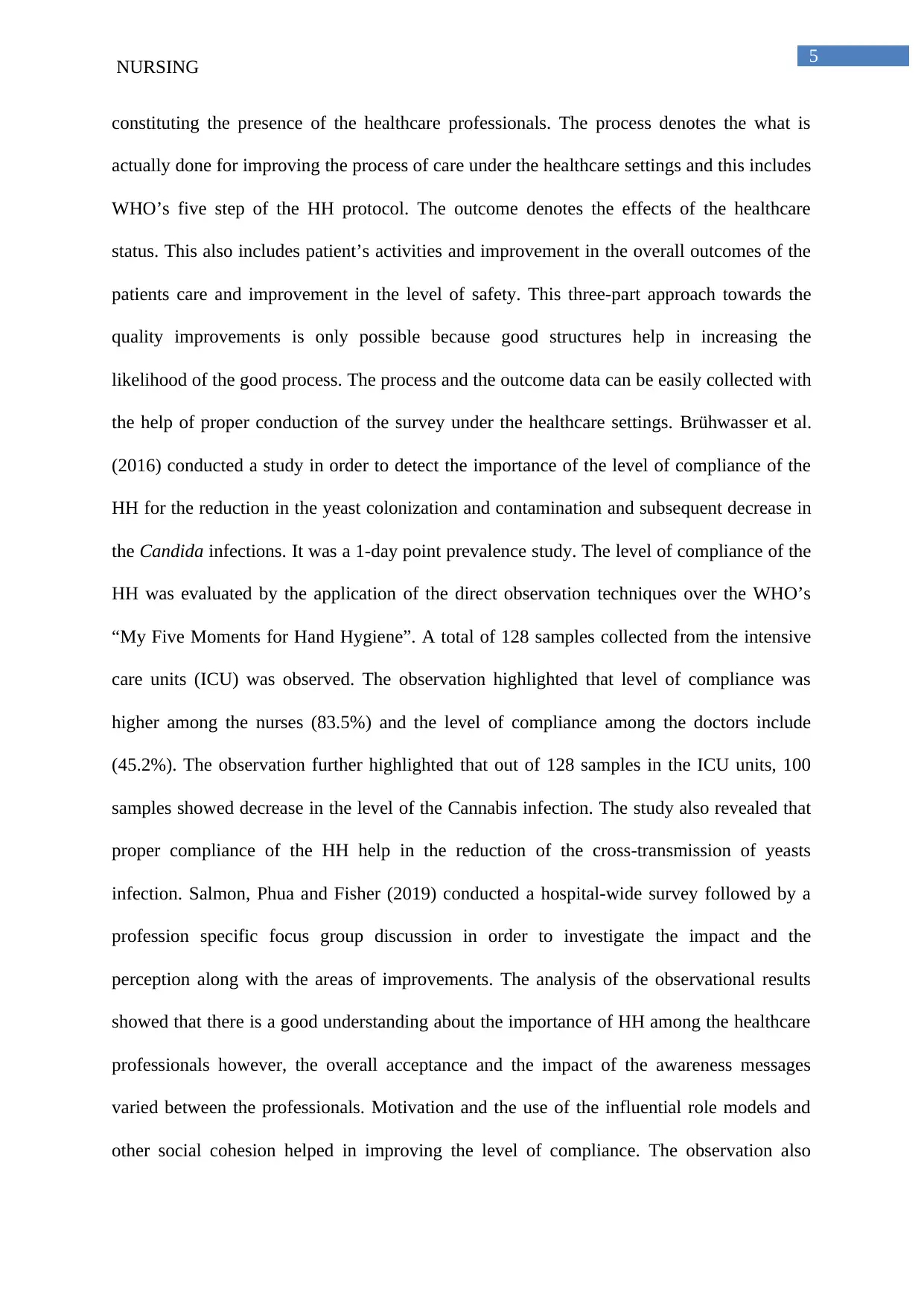
5
NURSING
constituting the presence of the healthcare professionals. The process denotes the what is
actually done for improving the process of care under the healthcare settings and this includes
WHO’s five step of the HH protocol. The outcome denotes the effects of the healthcare
status. This also includes patient’s activities and improvement in the overall outcomes of the
patients care and improvement in the level of safety. This three-part approach towards the
quality improvements is only possible because good structures help in increasing the
likelihood of the good process. The process and the outcome data can be easily collected with
the help of proper conduction of the survey under the healthcare settings. Brühwasser et al.
(2016) conducted a study in order to detect the importance of the level of compliance of the
HH for the reduction in the yeast colonization and contamination and subsequent decrease in
the Candida infections. It was a 1-day point prevalence study. The level of compliance of the
HH was evaluated by the application of the direct observation techniques over the WHO’s
“My Five Moments for Hand Hygiene”. A total of 128 samples collected from the intensive
care units (ICU) was observed. The observation highlighted that level of compliance was
higher among the nurses (83.5%) and the level of compliance among the doctors include
(45.2%). The observation further highlighted that out of 128 samples in the ICU units, 100
samples showed decrease in the level of the Cannabis infection. The study also revealed that
proper compliance of the HH help in the reduction of the cross-transmission of yeasts
infection. Salmon, Phua and Fisher (2019) conducted a hospital-wide survey followed by a
profession specific focus group discussion in order to investigate the impact and the
perception along with the areas of improvements. The analysis of the observational results
showed that there is a good understanding about the importance of HH among the healthcare
professionals however, the overall acceptance and the impact of the awareness messages
varied between the professionals. Motivation and the use of the influential role models and
other social cohesion helped in improving the level of compliance. The observation also
NURSING
constituting the presence of the healthcare professionals. The process denotes the what is
actually done for improving the process of care under the healthcare settings and this includes
WHO’s five step of the HH protocol. The outcome denotes the effects of the healthcare
status. This also includes patient’s activities and improvement in the overall outcomes of the
patients care and improvement in the level of safety. This three-part approach towards the
quality improvements is only possible because good structures help in increasing the
likelihood of the good process. The process and the outcome data can be easily collected with
the help of proper conduction of the survey under the healthcare settings. Brühwasser et al.
(2016) conducted a study in order to detect the importance of the level of compliance of the
HH for the reduction in the yeast colonization and contamination and subsequent decrease in
the Candida infections. It was a 1-day point prevalence study. The level of compliance of the
HH was evaluated by the application of the direct observation techniques over the WHO’s
“My Five Moments for Hand Hygiene”. A total of 128 samples collected from the intensive
care units (ICU) was observed. The observation highlighted that level of compliance was
higher among the nurses (83.5%) and the level of compliance among the doctors include
(45.2%). The observation further highlighted that out of 128 samples in the ICU units, 100
samples showed decrease in the level of the Cannabis infection. The study also revealed that
proper compliance of the HH help in the reduction of the cross-transmission of yeasts
infection. Salmon, Phua and Fisher (2019) conducted a hospital-wide survey followed by a
profession specific focus group discussion in order to investigate the impact and the
perception along with the areas of improvements. The analysis of the observational results
showed that there is a good understanding about the importance of HH among the healthcare
professionals however, the overall acceptance and the impact of the awareness messages
varied between the professionals. Motivation and the use of the influential role models and
other social cohesion helped in improving the level of compliance. The observation also
⊘ This is a preview!⊘
Do you want full access?
Subscribe today to unlock all pages.

Trusted by 1+ million students worldwide
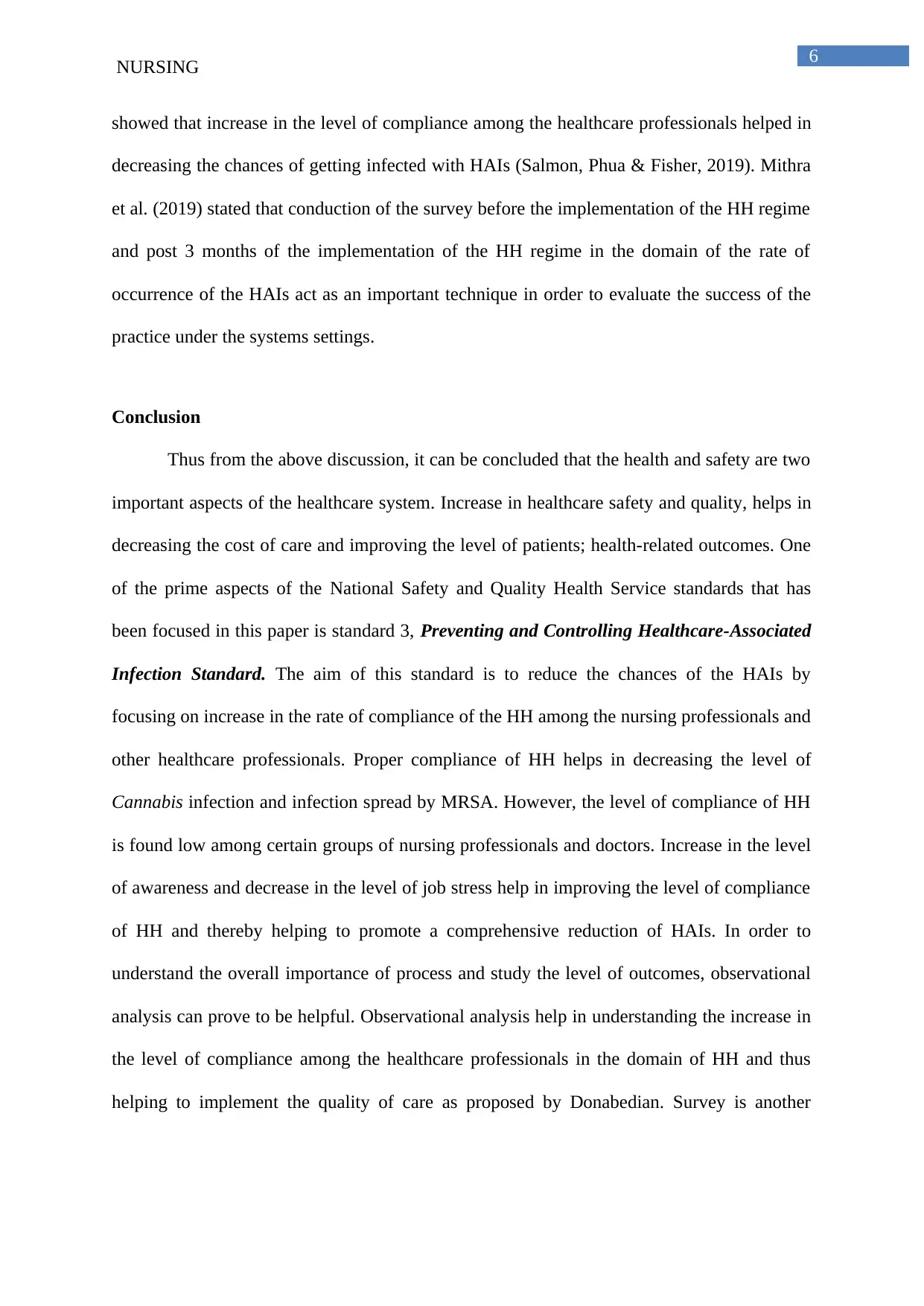
6
NURSING
showed that increase in the level of compliance among the healthcare professionals helped in
decreasing the chances of getting infected with HAIs (Salmon, Phua & Fisher, 2019). Mithra
et al. (2019) stated that conduction of the survey before the implementation of the HH regime
and post 3 months of the implementation of the HH regime in the domain of the rate of
occurrence of the HAIs act as an important technique in order to evaluate the success of the
practice under the systems settings.
Conclusion
Thus from the above discussion, it can be concluded that the health and safety are two
important aspects of the healthcare system. Increase in healthcare safety and quality, helps in
decreasing the cost of care and improving the level of patients; health-related outcomes. One
of the prime aspects of the National Safety and Quality Health Service standards that has
been focused in this paper is standard 3, Preventing and Controlling Healthcare-Associated
Infection Standard. The aim of this standard is to reduce the chances of the HAIs by
focusing on increase in the rate of compliance of the HH among the nursing professionals and
other healthcare professionals. Proper compliance of HH helps in decreasing the level of
Cannabis infection and infection spread by MRSA. However, the level of compliance of HH
is found low among certain groups of nursing professionals and doctors. Increase in the level
of awareness and decrease in the level of job stress help in improving the level of compliance
of HH and thereby helping to promote a comprehensive reduction of HAIs. In order to
understand the overall importance of process and study the level of outcomes, observational
analysis can prove to be helpful. Observational analysis help in understanding the increase in
the level of compliance among the healthcare professionals in the domain of HH and thus
helping to implement the quality of care as proposed by Donabedian. Survey is another
NURSING
showed that increase in the level of compliance among the healthcare professionals helped in
decreasing the chances of getting infected with HAIs (Salmon, Phua & Fisher, 2019). Mithra
et al. (2019) stated that conduction of the survey before the implementation of the HH regime
and post 3 months of the implementation of the HH regime in the domain of the rate of
occurrence of the HAIs act as an important technique in order to evaluate the success of the
practice under the systems settings.
Conclusion
Thus from the above discussion, it can be concluded that the health and safety are two
important aspects of the healthcare system. Increase in healthcare safety and quality, helps in
decreasing the cost of care and improving the level of patients; health-related outcomes. One
of the prime aspects of the National Safety and Quality Health Service standards that has
been focused in this paper is standard 3, Preventing and Controlling Healthcare-Associated
Infection Standard. The aim of this standard is to reduce the chances of the HAIs by
focusing on increase in the rate of compliance of the HH among the nursing professionals and
other healthcare professionals. Proper compliance of HH helps in decreasing the level of
Cannabis infection and infection spread by MRSA. However, the level of compliance of HH
is found low among certain groups of nursing professionals and doctors. Increase in the level
of awareness and decrease in the level of job stress help in improving the level of compliance
of HH and thereby helping to promote a comprehensive reduction of HAIs. In order to
understand the overall importance of process and study the level of outcomes, observational
analysis can prove to be helpful. Observational analysis help in understanding the increase in
the level of compliance among the healthcare professionals in the domain of HH and thus
helping to implement the quality of care as proposed by Donabedian. Survey is another
Paraphrase This Document
Need a fresh take? Get an instant paraphrase of this document with our AI Paraphraser
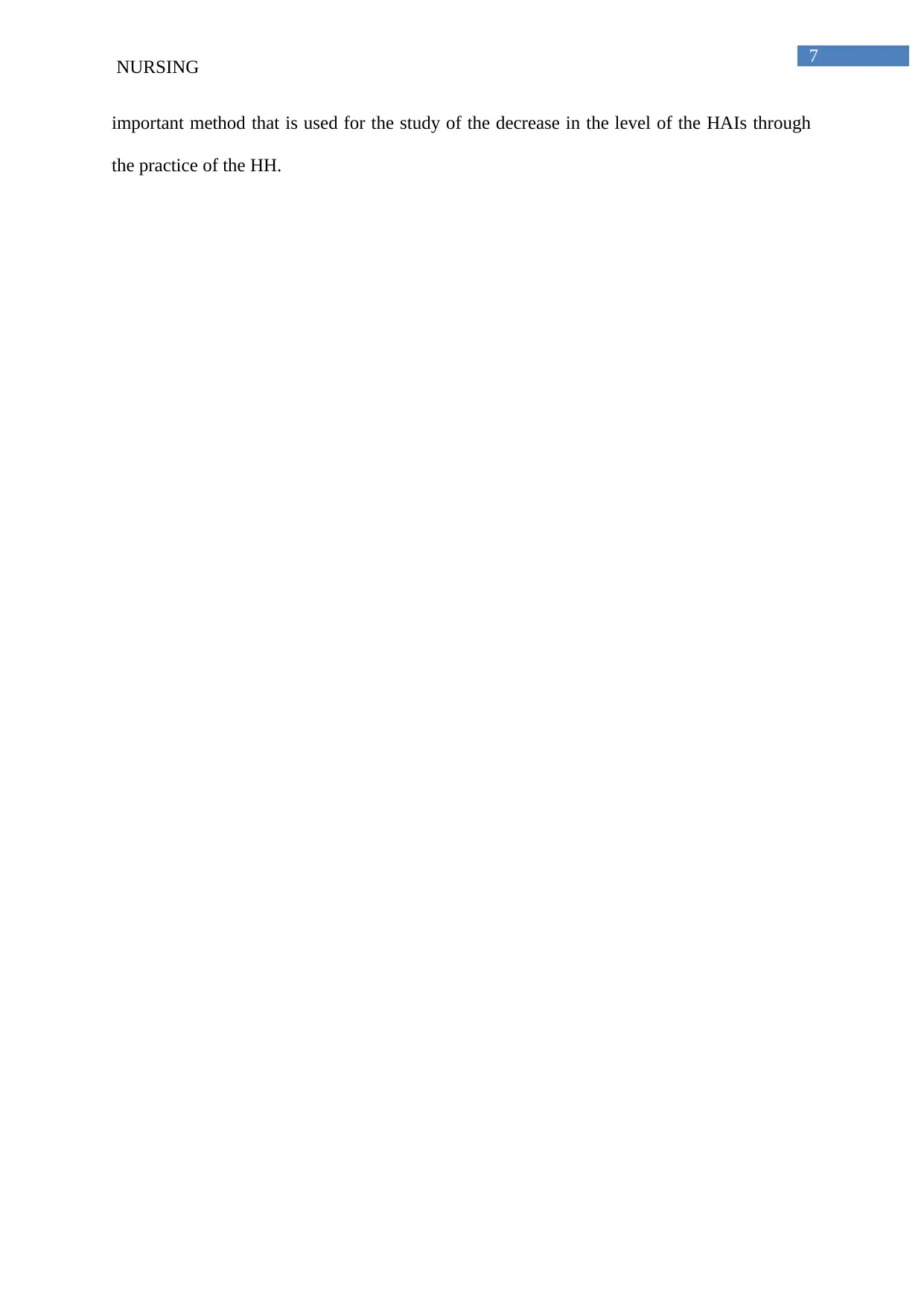
7
NURSING
important method that is used for the study of the decrease in the level of the HAIs through
the practice of the HH.
NURSING
important method that is used for the study of the decrease in the level of the HAIs through
the practice of the HH.
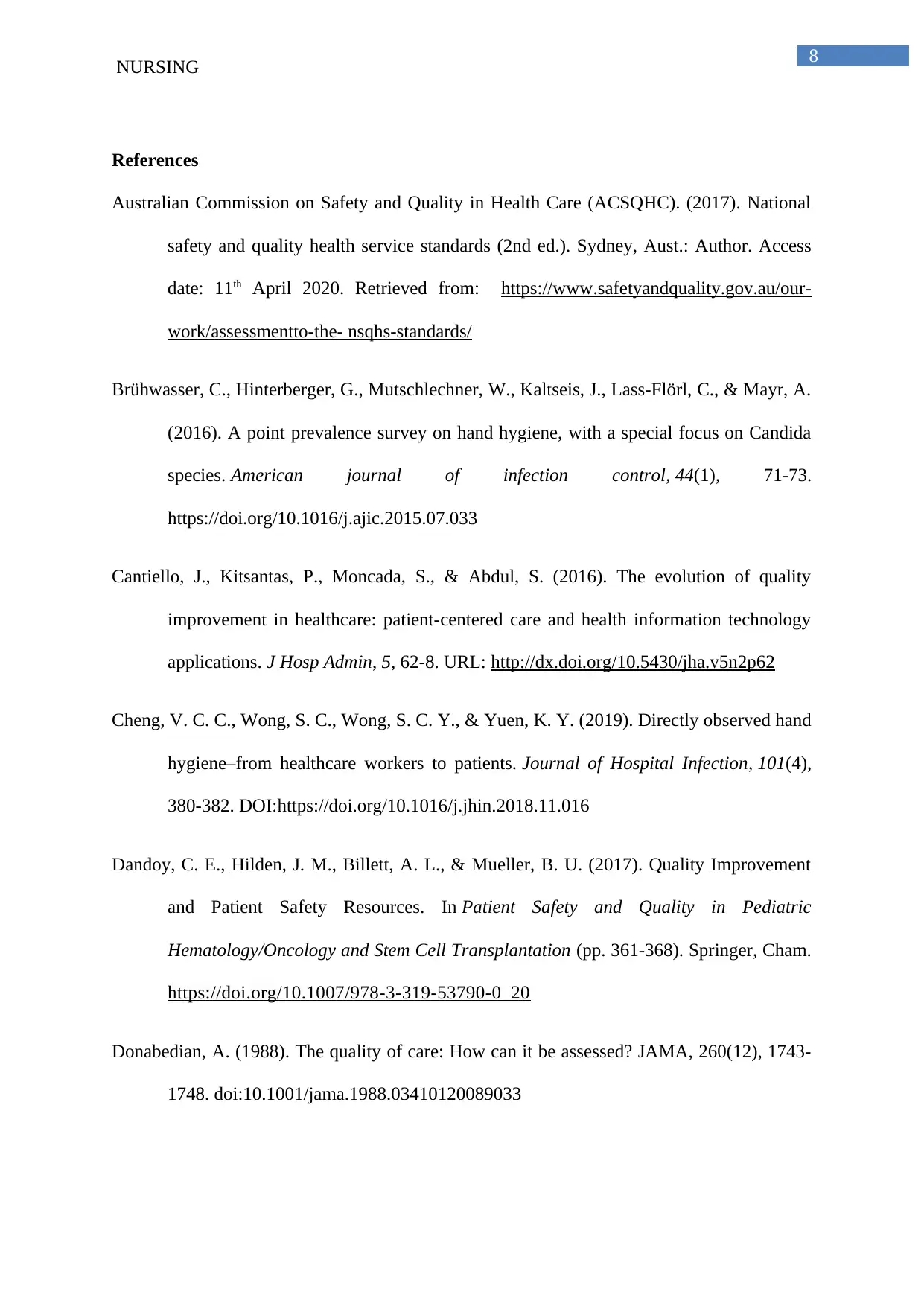
8
NURSING
References
Australian Commission on Safety and Quality in Health Care (ACSQHC). (2017). National
safety and quality health service standards (2nd ed.). Sydney, Aust.: Author. Access
date: 11th April 2020. Retrieved from: https://www.safetyandquality.gov.au/our-
work/assessmentto-the- nsqhs-standards/
Brühwasser, C., Hinterberger, G., Mutschlechner, W., Kaltseis, J., Lass-Flörl, C., & Mayr, A.
(2016). A point prevalence survey on hand hygiene, with a special focus on Candida
species. American journal of infection control, 44(1), 71-73.
https://doi.org/10.1016/j.ajic.2015.07.033
Cantiello, J., Kitsantas, P., Moncada, S., & Abdul, S. (2016). The evolution of quality
improvement in healthcare: patient-centered care and health information technology
applications. J Hosp Admin, 5, 62-8. URL: http://dx.doi.org/10.5430/jha.v5n2p62
Cheng, V. C. C., Wong, S. C., Wong, S. C. Y., & Yuen, K. Y. (2019). Directly observed hand
hygiene–from healthcare workers to patients. Journal of Hospital Infection, 101(4),
380-382. DOI:https://doi.org/10.1016/j.jhin.2018.11.016
Dandoy, C. E., Hilden, J. M., Billett, A. L., & Mueller, B. U. (2017). Quality Improvement
and Patient Safety Resources. In Patient Safety and Quality in Pediatric
Hematology/Oncology and Stem Cell Transplantation (pp. 361-368). Springer, Cham.
https://doi.org/10.1007/978-3-319-53790-0_20
Donabedian, A. (1988). The quality of care: How can it be assessed? JAMA, 260(12), 1743-
1748. doi:10.1001/jama.1988.03410120089033
NURSING
References
Australian Commission on Safety and Quality in Health Care (ACSQHC). (2017). National
safety and quality health service standards (2nd ed.). Sydney, Aust.: Author. Access
date: 11th April 2020. Retrieved from: https://www.safetyandquality.gov.au/our-
work/assessmentto-the- nsqhs-standards/
Brühwasser, C., Hinterberger, G., Mutschlechner, W., Kaltseis, J., Lass-Flörl, C., & Mayr, A.
(2016). A point prevalence survey on hand hygiene, with a special focus on Candida
species. American journal of infection control, 44(1), 71-73.
https://doi.org/10.1016/j.ajic.2015.07.033
Cantiello, J., Kitsantas, P., Moncada, S., & Abdul, S. (2016). The evolution of quality
improvement in healthcare: patient-centered care and health information technology
applications. J Hosp Admin, 5, 62-8. URL: http://dx.doi.org/10.5430/jha.v5n2p62
Cheng, V. C. C., Wong, S. C., Wong, S. C. Y., & Yuen, K. Y. (2019). Directly observed hand
hygiene–from healthcare workers to patients. Journal of Hospital Infection, 101(4),
380-382. DOI:https://doi.org/10.1016/j.jhin.2018.11.016
Dandoy, C. E., Hilden, J. M., Billett, A. L., & Mueller, B. U. (2017). Quality Improvement
and Patient Safety Resources. In Patient Safety and Quality in Pediatric
Hematology/Oncology and Stem Cell Transplantation (pp. 361-368). Springer, Cham.
https://doi.org/10.1007/978-3-319-53790-0_20
Donabedian, A. (1988). The quality of care: How can it be assessed? JAMA, 260(12), 1743-
1748. doi:10.1001/jama.1988.03410120089033
⊘ This is a preview!⊘
Do you want full access?
Subscribe today to unlock all pages.

Trusted by 1+ million students worldwide
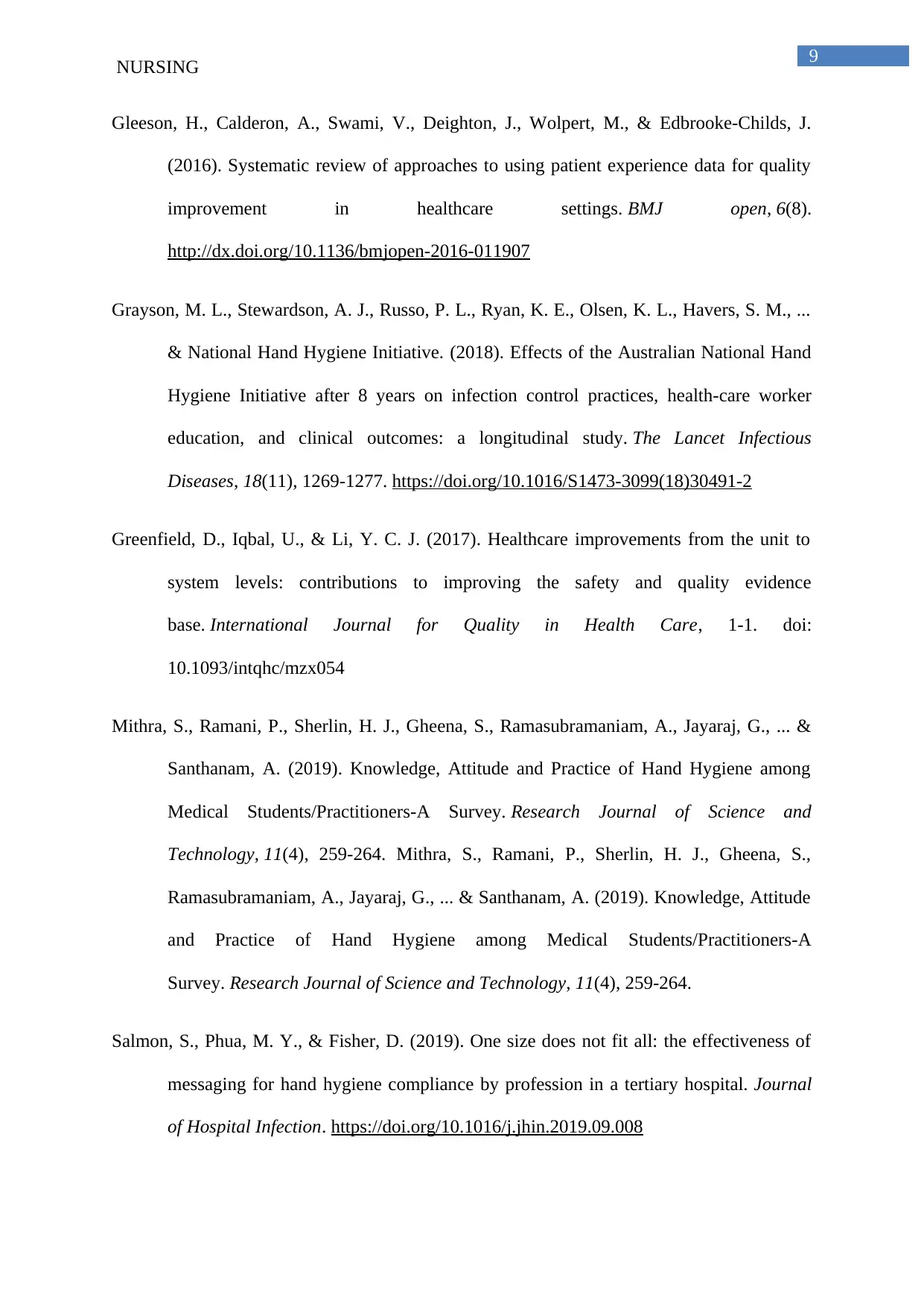
9
NURSING
Gleeson, H., Calderon, A., Swami, V., Deighton, J., Wolpert, M., & Edbrooke-Childs, J.
(2016). Systematic review of approaches to using patient experience data for quality
improvement in healthcare settings. BMJ open, 6(8).
http://dx.doi.org/10.1136/bmjopen-2016-011907
Grayson, M. L., Stewardson, A. J., Russo, P. L., Ryan, K. E., Olsen, K. L., Havers, S. M., ...
& National Hand Hygiene Initiative. (2018). Effects of the Australian National Hand
Hygiene Initiative after 8 years on infection control practices, health-care worker
education, and clinical outcomes: a longitudinal study. The Lancet Infectious
Diseases, 18(11), 1269-1277. https://doi.org/10.1016/S1473-3099(18)30491-2
Greenfield, D., Iqbal, U., & Li, Y. C. J. (2017). Healthcare improvements from the unit to
system levels: contributions to improving the safety and quality evidence
base. International Journal for Quality in Health Care, 1-1. doi:
10.1093/intqhc/mzx054
Mithra, S., Ramani, P., Sherlin, H. J., Gheena, S., Ramasubramaniam, A., Jayaraj, G., ... &
Santhanam, A. (2019). Knowledge, Attitude and Practice of Hand Hygiene among
Medical Students/Practitioners-A Survey. Research Journal of Science and
Technology, 11(4), 259-264. Mithra, S., Ramani, P., Sherlin, H. J., Gheena, S.,
Ramasubramaniam, A., Jayaraj, G., ... & Santhanam, A. (2019). Knowledge, Attitude
and Practice of Hand Hygiene among Medical Students/Practitioners-A
Survey. Research Journal of Science and Technology, 11(4), 259-264.
Salmon, S., Phua, M. Y., & Fisher, D. (2019). One size does not fit all: the effectiveness of
messaging for hand hygiene compliance by profession in a tertiary hospital. Journal
of Hospital Infection. https://doi.org/10.1016/j.jhin.2019.09.008
NURSING
Gleeson, H., Calderon, A., Swami, V., Deighton, J., Wolpert, M., & Edbrooke-Childs, J.
(2016). Systematic review of approaches to using patient experience data for quality
improvement in healthcare settings. BMJ open, 6(8).
http://dx.doi.org/10.1136/bmjopen-2016-011907
Grayson, M. L., Stewardson, A. J., Russo, P. L., Ryan, K. E., Olsen, K. L., Havers, S. M., ...
& National Hand Hygiene Initiative. (2018). Effects of the Australian National Hand
Hygiene Initiative after 8 years on infection control practices, health-care worker
education, and clinical outcomes: a longitudinal study. The Lancet Infectious
Diseases, 18(11), 1269-1277. https://doi.org/10.1016/S1473-3099(18)30491-2
Greenfield, D., Iqbal, U., & Li, Y. C. J. (2017). Healthcare improvements from the unit to
system levels: contributions to improving the safety and quality evidence
base. International Journal for Quality in Health Care, 1-1. doi:
10.1093/intqhc/mzx054
Mithra, S., Ramani, P., Sherlin, H. J., Gheena, S., Ramasubramaniam, A., Jayaraj, G., ... &
Santhanam, A. (2019). Knowledge, Attitude and Practice of Hand Hygiene among
Medical Students/Practitioners-A Survey. Research Journal of Science and
Technology, 11(4), 259-264. Mithra, S., Ramani, P., Sherlin, H. J., Gheena, S.,
Ramasubramaniam, A., Jayaraj, G., ... & Santhanam, A. (2019). Knowledge, Attitude
and Practice of Hand Hygiene among Medical Students/Practitioners-A
Survey. Research Journal of Science and Technology, 11(4), 259-264.
Salmon, S., Phua, M. Y., & Fisher, D. (2019). One size does not fit all: the effectiveness of
messaging for hand hygiene compliance by profession in a tertiary hospital. Journal
of Hospital Infection. https://doi.org/10.1016/j.jhin.2019.09.008
Paraphrase This Document
Need a fresh take? Get an instant paraphrase of this document with our AI Paraphraser
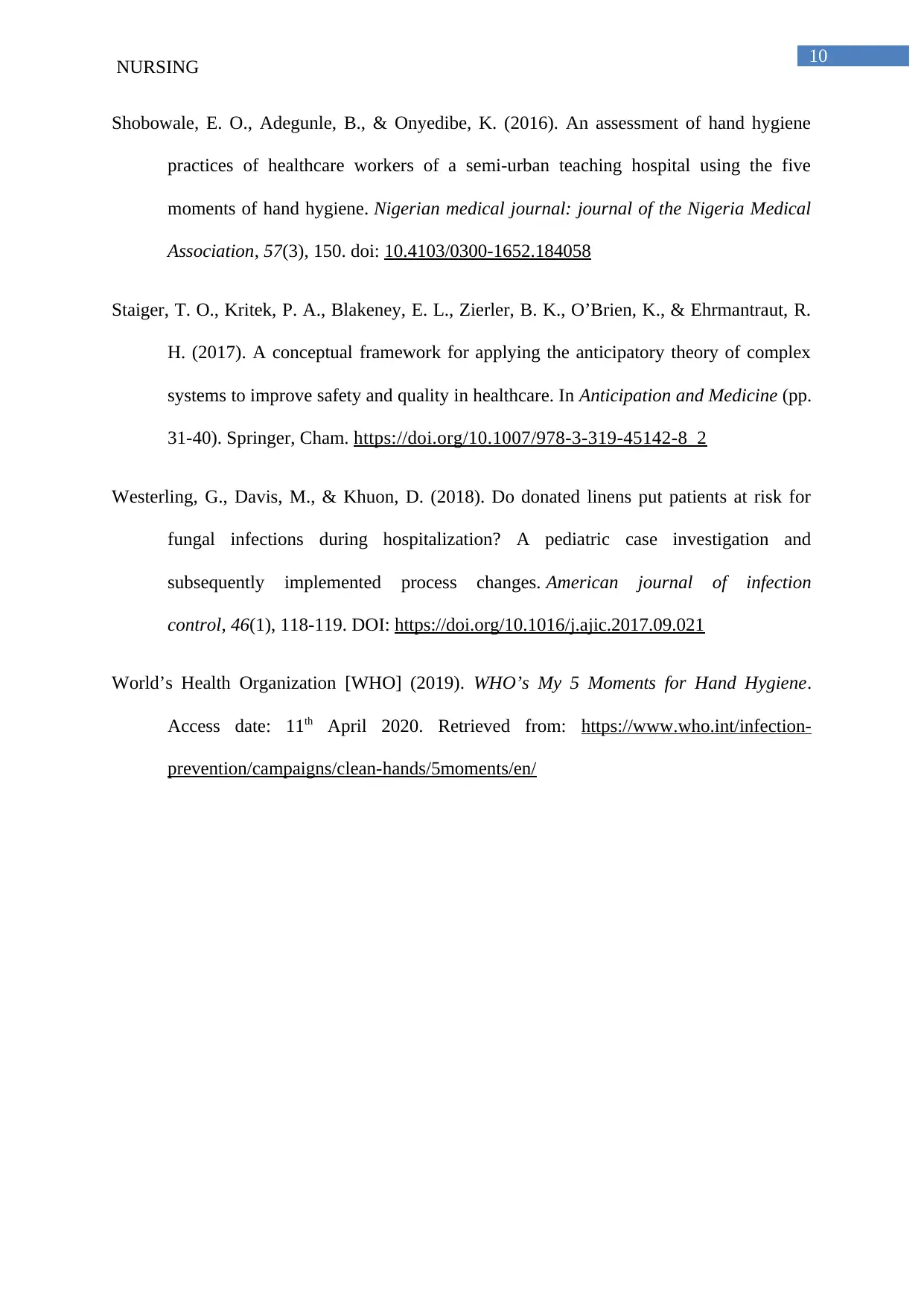
10
NURSING
Shobowale, E. O., Adegunle, B., & Onyedibe, K. (2016). An assessment of hand hygiene
practices of healthcare workers of a semi-urban teaching hospital using the five
moments of hand hygiene. Nigerian medical journal: journal of the Nigeria Medical
Association, 57(3), 150. doi: 10.4103/0300-1652.184058
Staiger, T. O., Kritek, P. A., Blakeney, E. L., Zierler, B. K., O’Brien, K., & Ehrmantraut, R.
H. (2017). A conceptual framework for applying the anticipatory theory of complex
systems to improve safety and quality in healthcare. In Anticipation and Medicine (pp.
31-40). Springer, Cham. https://doi.org/10.1007/978-3-319-45142-8_2
Westerling, G., Davis, M., & Khuon, D. (2018). Do donated linens put patients at risk for
fungal infections during hospitalization? A pediatric case investigation and
subsequently implemented process changes. American journal of infection
control, 46(1), 118-119. DOI: https://doi.org/10.1016/j.ajic.2017.09.021
World’s Health Organization [WHO] (2019). WHO’s My 5 Moments for Hand Hygiene.
Access date: 11th April 2020. Retrieved from: https://www.who.int/infection-
prevention/campaigns/clean-hands/5moments/en/
NURSING
Shobowale, E. O., Adegunle, B., & Onyedibe, K. (2016). An assessment of hand hygiene
practices of healthcare workers of a semi-urban teaching hospital using the five
moments of hand hygiene. Nigerian medical journal: journal of the Nigeria Medical
Association, 57(3), 150. doi: 10.4103/0300-1652.184058
Staiger, T. O., Kritek, P. A., Blakeney, E. L., Zierler, B. K., O’Brien, K., & Ehrmantraut, R.
H. (2017). A conceptual framework for applying the anticipatory theory of complex
systems to improve safety and quality in healthcare. In Anticipation and Medicine (pp.
31-40). Springer, Cham. https://doi.org/10.1007/978-3-319-45142-8_2
Westerling, G., Davis, M., & Khuon, D. (2018). Do donated linens put patients at risk for
fungal infections during hospitalization? A pediatric case investigation and
subsequently implemented process changes. American journal of infection
control, 46(1), 118-119. DOI: https://doi.org/10.1016/j.ajic.2017.09.021
World’s Health Organization [WHO] (2019). WHO’s My 5 Moments for Hand Hygiene.
Access date: 11th April 2020. Retrieved from: https://www.who.int/infection-
prevention/campaigns/clean-hands/5moments/en/
1 out of 11
Related Documents
Your All-in-One AI-Powered Toolkit for Academic Success.
+13062052269
info@desklib.com
Available 24*7 on WhatsApp / Email
![[object Object]](/_next/static/media/star-bottom.7253800d.svg)
Unlock your academic potential
Copyright © 2020–2025 A2Z Services. All Rights Reserved. Developed and managed by ZUCOL.





